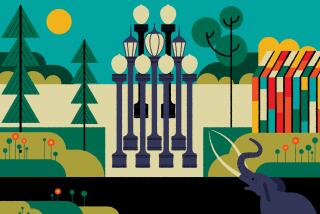Kids Keep in Touch at Museum Exhibit : Art: Bowers takes interactive approach to activities, attractions from different cultures.
- Share via
SANTA ANA — With a small drum clamped between his knees, a giggling Jose Urias, 13, beat the Native American instrument with his hands as he was accompanied by an entourage of other novice musicians.
Amid the wild rhythms of the drum, rattling maracas and crescendos of children’s laughter, Urias, of Santa Ana, was one of hundreds of kids Sunday sampling the activities and attractions at the Bowers Museum’s first cultural exhibit especially for children.
At the opening of the Kidseum in Santa Ana, two blocks from the Bowers’ main Museum of Cultural Arts, families and tour groups curiously stroked furs from native rugs, strummed guitars and put wooden masks over their heads.
Unlike most museums, there were no “DO NOT TOUCH” warning signs. Instead, makeshift flyers of colorful construction paper encouraged gentle handling and testing of musical instruments, costumes and tools.
The interactive premise behind the museum, coordinator Pat Korzec said, is to get visitors, young and old, to absorb the different cultures by involving their human senses.
“Everything here is touchable. It’s a normal reaction to reach out and feel what’s in front of you, to really experience the culture,” Korzec said. “I didn’t expect to see this level of concentration.”
The majority of Kidseum’s exhibits and programs focus on the three cultural regions emphasized at the main museum: The Americas, the Pacific Rim and Africa. Most visiting children ranged from ages 2 to 13.
“This is great,” said an elated David Grody, 7, of Orange. “I’ve just touched about everything. This is almost better than the L.A. Children’s Museum.”
“My favorite is the rabbit fur, because it’s soft,” Brittany Bronagem, 5, said timidly.
Although the overall responses were delight and amusement, Sandra Vu, 13, of Santa Ana, said, “I think this is kind of boring. It’s educational but it’s more for young kids.”
But museum organizers also expect participation from parents and educators.
For Victor Carfi and his son, Alex, just shy of 3 years old, the cultural experience was an eye opener.
“Most other children’s museums are usually about science and nature. Here, we listened to stories about the Chumach Indians, played the guitar and tried on costumes,” said Carfi, of Los Alamitos. “I don’t know much about this kind of stuff.”
Milling through the museum’s time vault, helping repair broken artifacts and rubbing little fingers along stone artwork brought out the archeologist and explorer in most children.
Volunteers were kept busy, trying to calm excited musicians and adventurers.
While some children fought to get their hands on bells and rabbit furs, others banged and jumped on such animal statues as saddled horses. Just two hours after museum doors opened, two maracas were already broken.
“It’s going to be a high-maintenance museum, but it’s worth it. I don’t think anyone can put a price tag on learning,” Korzec said.
Inside a glass room, dotted with bean bags and cushions, children and parents sat in a horseshoe around a storyteller recounting oral histories of indigenous peoples. Some alert listeners perked their ears up and engaged in the stories. Others fidgeted and darted toward the touchable items once the hourlong session ended.
In another room, the child archeologist would transform into a primitive artist, creating posters and toys with imaginative icons and designs. Children carried away simulated African rattles made by filling empty tennis ball canisters with corn kernels and covering them with symbols and icons.
“These kids’ imaginations are far more sophisticated than adults think. They’ll come up with things well beyond the structures we teach them,” said John Rose, a museum volunteer. “I look over their shoulders and I learn from them.”
More to Read
The biggest entertainment stories
Get our big stories about Hollywood, film, television, music, arts, culture and more right in your inbox as soon as they publish.
You may occasionally receive promotional content from the Los Angeles Times.










